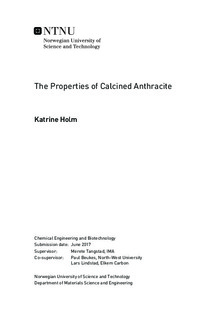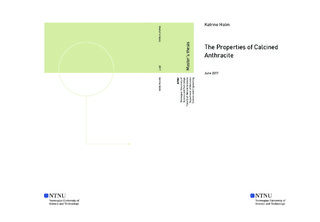| dc.description.abstract | The aim of this thesis has been to look at the thermal behaviour of anthracite, coke and charcoal regarding their expansion during heating and their release of off-gases. Furthermore, to look at how the porosity and expansion of the anthracite is affected by the different temperatures during the calcining process. Two anthracites (A11 and A19), two cokes (C3 and C7) and one charcoal (BIO) were investigated.
The porosity and surface area of A11 calcined at different temperatures were investigated by porosity calculations from envelope and absolute density measurements, and from BET surface area measurements with N2 gas adsorption. The porosity of A11 was found to decrease with increasing calcining temperature up to 1800 C and increase between 1800 and 2650 C. A significant difference in the surface area from 27.4 to 0.2 m^2/g was found between the materials calcined at 600 and 1100 C, while an incremental increase was observed between 1100 and 2650 C. The high surface area of the non-calcined A11 and A11 calcined at 600 C can be explain the high porosity for these temperature samples.
Single grains of A11 calcined at 1100, 1800 and 2650 C were heated to 1550 C in a pushrod dilatometer in order to investigate the thermal expansion. The thermal expansion coefficient (TEC) was found to decrease with increasing calcining temperature. Both the material calcined at 1800 and 2650 C had a TEC close to the TEC of graphite of about 3*10^-6 /C, indicating graphitization. The material calcined at 1100 C showed a higher TEC value of 15*10^-6 /C.
The thermal expansion was also investigated with an Exstar SS6300 TMA, using pelletized material. Two heating cycles to 1400 C were carried out. A shrinkage was found during the first heating above 600 C due to volatiles leaving the carbon matrix. A linear relationship between the TEC from the first heating and the volatile content of the samples were found. The non-calcined A11 and A11 calcined at 600, 800 and 1000C revealed a trend where the shrinkage decrease with increasing calcining temperature. A linear relationship between the shrinkage and the volatile content was found in the temperature range where volatiles are driven off. Similar shrinkage was observed for the non-calcined A19, A19 calcined at 600 C, C7 and BIO.
For the second heating all materials were found to contract the same amount during cooling as they expand during heating. The expansion at 1400 C was found to be between 0.6 and 0.9 % for all samples. For C3 and the anthracites calcined at 1200 C or higher, no shrinkage occurred. The expansion was found to be similar for both temperature cycles, with only a small decrease in the average TEC values between the first and the second heating. The TEC values during the second heating were found to be very stable between 400 and 1100 C. For all samples the TEC values were found to lay between 5 and 8 *10^-6 /C, indicating graphitization. A high reproducibility was found for the thermal behaviour experiments carried out in the Exstar SS6300 TMA.
Mass loss and the derivative of mass during heating to 1500 C was investigated for all samples by using an STA 449 F3 Jupiter and an Elite tube furnace. The STA was found to be more accurate and the results are reproducible. The mass loss of A11 and A19 during heating to 1500 C comply with the mass losses during the calcining process. The derivative of mass curves showed the highest increase around 600-700 C for all samples. The increase was found to be higher for A19 than for A11 samples due to the higher volatile content.
The off-gases during heating of all samples were investigated by connecting a Fourier transform infrared (FTIR) detector and a gas chromatography with mass spectrometry (GC-MS) to the STA. The FTIR spectra showed CO2, CO and H2O for all samples except C3, where only CO2 and CO were detected. From the GC-MS analysis, only CO2 was detected and these results correlates with the FTIR analysis. The amount of CO2 was found to increase with increasing temperature for all samples, and the highest amount of CO2 was found for BIO. CO appears around 700 C and the amount was found to increase with increasing temperature. The FTIR spectra also indicated polycyclic aromatic hydrocarbons around 600-700 C for the non-calcined anthracites, A19 calcined at 600 C and BIO.
Finally, a multiple linear regression analysis was carried out to suggest correlations between different properties, how they affect each other and how they are affected by the thermal treatment. A root mean square error of zero was obtained for the total porosity of A11 with an optimum equation containing the hydrogen content, the ash content and the BET surface area. Similar results were obtained for the dimensional behaviour of the anthracites during the first heating to1400 C by including the sulfur, volatile and ash content in the equation. | |

